"Canarias, Por Una Costa Viva" (Canaries, For An Alive
Coast) An educational and research initiative to enhance the sustainable
use of the Canarian coasts
Ricardo Haroun Tabraue and Yaiza Fernández-Palacios Vallejo
Mediateca Guiniguada. Camino de Salvago s/n. Campus de Tafira -
35017.
Las Palmas de Gran Canaria.
Spain.
Tel: +34 928 457 455
Fax. +34 928 457 457
rharoun@dbio.ulpgc.es,
yaizafv@iccm.rcanaria.es
www.canariasporunacostaviva.org
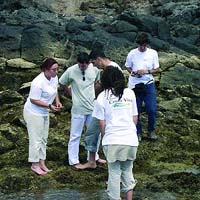 |
Guided trips to the seashore are
some of the activities run by the project.
|
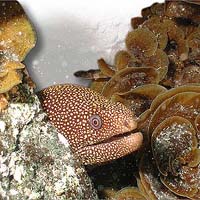 |
Gymnothorax miliaris.
Databases are used to keep and manage the sampling
results.
|
|
|
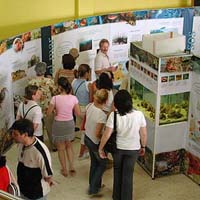 |
The display panels at the
exhibition are colourful and attractive to visitors.
|
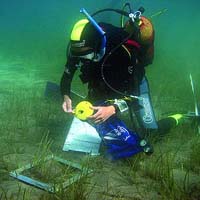 |
Sampling sea grasses. New
data for the Canarian list of endangered species will be
generated.
|
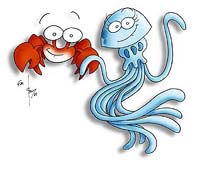 |
Project mascots Menuda and Chinijo (the
local words for a small boy and girl).
|
The aim of this project is to promote awareness of the biological and
socio-economic values of the Canarian coastline among coastal users.
Other underlying objectives include designing best practices for
management and sustainable use of the littoral resources. The working
team has two complementary divisions: research and education, which
incorporate a large social facet. This is a new and fresh approach to
littoral issues, at least in Spain.
"Canarias, por una Costa Viva" is fully supported by the
Spanish Ministry of Environment and is run by the University of Las
Palmas de Gran Canaria in conjunction with WWF-ADENA. Collaboration with
the Canarian Institute of Marine Sciences, the University of La Laguna,
Regional and Insular Agencies and some private companies enrich the
actions and outputs. The project started in August 2002 and will end in
November 2004.
Research The objectives of the research division are to: Analyse the
characteristics and environmental quality of the marine biological
communities. Determine the conservation status of selected marine
species and ecosystems. Analyse the relationship between the human
population and the natural environment as well as the pressures it
supports. Study ecological processes in intertidal and shallow subtidal
ecosystems.
The research activities are carried out with sampling every six
months in over 100 sites around the coastlines of the overall Canary
Islands. Marine biodiversity and water and sediment quality are measured
following standard research protocols. Sampled areas include: rocky
intertidal areas, brown algae forests, sea-urchin barren grounds and
seagrass meadows. Sampling sites are in both pristine and
anthropogenically stressed areas, in order to assess the effects of the
different pressures (pollution, shell fishing activity, urban
development, marinas, etc.).
At the end of the project an assessment of the environmental quality
of coastal areas in the Canary Islands will be produced. Littoral
environmental quality bioindicators and inputs to the Canarian list of
endangered species are only some of the results which will contribute to
the generation of tools for ICZM in the Canary Islands.
Education The education division works to: Raise public awareness of
the environmental and natural values of the Canarian coastline. Support
the education of the Canarian population and visitors towards the
sustainable use of the natural resources. Enhance public participation
in diverse coastal activities. Develop a full range of educational tools
for diverse social groups (schools, handicapped collectives, silver-age
groups, etc.).
These objectives are mainly achieved through three different types of
actions: an exhibition, the design of educational materials and
activities with social groups.
The exhibition created by "Canarias, por una Costa Viva"
includes display panels, models and an aquarium, which explain details
not only about the tides, biodiversity and different coastal landscapes,
but also about the traditional and modern activities developed in the
coast and the conservation and management issues related to them. The
exhibition will be on display in the principal cities and villages
within the seven islands. It will be the focal point for different
educational activities carried out by "Canarias, por una Costa
Viva" staff. Two pets, Menuda (a jellyfish) and Chinijo (a crab),
introduce the visitors to the coast. Its great fun to see children's'
faces along the visit!
Educational materials have been designed for students from primary
school level to university, as well as accompanying materials for
teachers. The contents refer to the natural values of the Canarian
littoral and are complemented by visits to the exhibition and guided
trips to the intertidal area.
Activities with social groups are based on a volunteering network
which will achieve joint activities like talks, cleaning of beaches,
snorkelling, littoral walks or collaborations with the research sampling
activities. The aim is to strengthen the relation of different social
groups with the natural environment and to create a common objective:
the protection of the coast.
|
